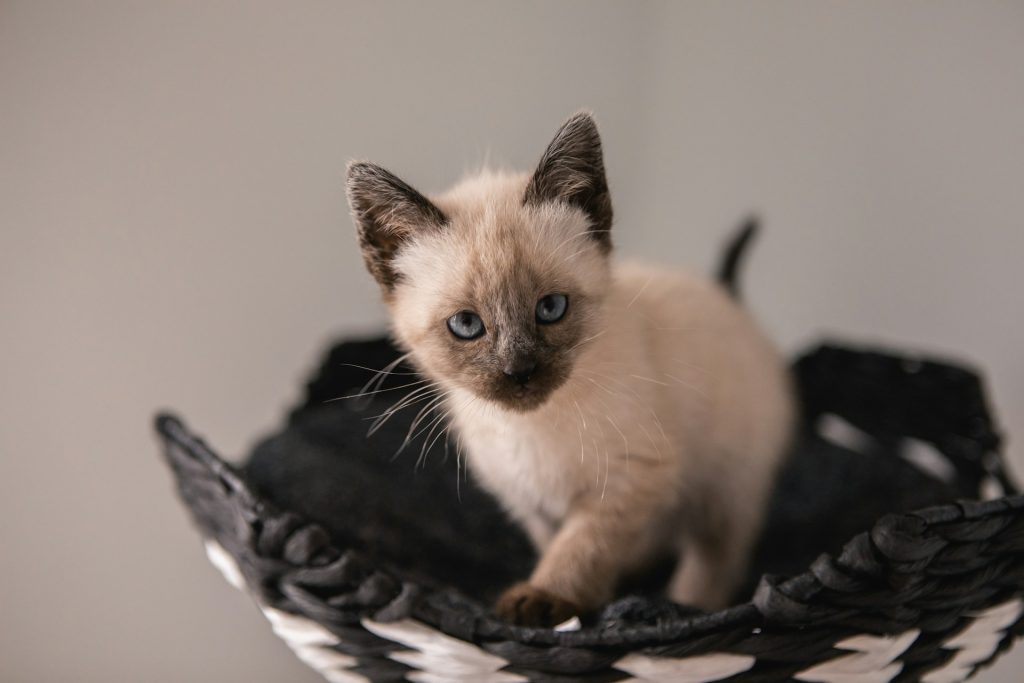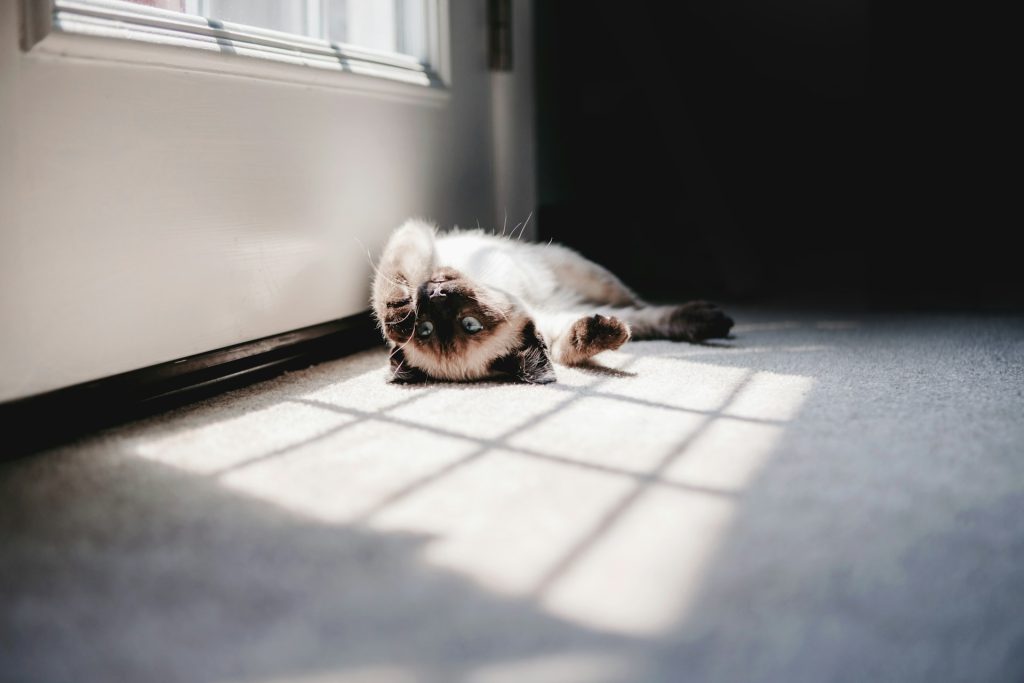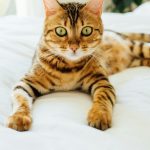Table of Contents
Whenever I find my cat snoozing on my head, I can’t help but wonder about the reasons why my cat sleeps there. Cats choose warm spots due to their higher body temperature than humans, and the heat from my head provides the perfect cozy spot for them. Additionally, this behavior may be a sign of affection; my personal space is their chosen territory, reinforcing the bond we share.
Sleeping near your head could also be a cat’s way of claiming their favorite human since pet parents emit a unique scent that comforts them. While it might infringe on my personal space, letting my cat sleep on my pillow is a small concession for the trust and love it represents. There’s a variety of reasons, but warmth and bonding seem to be at the heart of this quirky sleeping habit.
Understanding Your Cat’s Sleep Habits
Cats are known for their peculiar sleeping habits, and my Siamese are no exception. Their tendency to sleep on your head or nearby could be a natural behavior related to their need for warmth and security. Recognizing this as part of their instinctual patterns helps me appreciate their presence and the comfort they find in being close to me.
The Quest for Warmth and Comfort
One of the reasons cats may sleep on their pet parent’s head is the quest for warmth. The cat’s normal body temperature ranges from 100 to 102 degrees Fahrenheit, and they are often on the lookout for heated bed-like environments to maintain that warmth. My head, not usually covered by blankets, becomes an ideal source of body heat for them.
Understanding this, I’ve invested in a cozy bed specifically designed to cater to my cat’s body temperature preferences. However, it seems that the allure of my natural warmth is still more appealing to them, as I often wake up to find them curled up on my pillow, basking in the heat I provide.
Scent Bonding and Territorial Behavior
The strong unique scent of my head, thanks to the numerous sweat and oil glands, seems to be a beacon for my cat. As they sleep near my head and rub against it, our scents mingle, reinforcing the bond between us. This scent bonding makes them feel safe and secure, creating a shared territory that we both belong to.
My Siamese cats also display territorial behavior by rubbing their faces against me to mark their territory with their unique scent. This behavior is especially evident when they sleep on my pillow, leaving behind a scent trail that signifies their presence and claim over the area, and by extension, over me.
The Trust Factor: Safety and Security in Numbers
When my cat sleeps on my head, it’s not just about comfort—it’s a declaration of trust. Since cats are most vulnerable when they’re sleeping, choosing this spot signifies that they feel protected by me. It’s touching to know that they see me as a guardian, even when we’re both at our most defenseless during sleep.
This trust is a critical aspect of our relationship, and I take it as a compliment that they chose the top of my head as their safe space. It’s a reminder that we’re a family, and our bond goes beyond mere companionship—it’s about mutual protection and comfort throughout the night.

Decoding the Affection: Your Cat’s Love Language
Cats have a unique way of expressing love, and sleeping on my head is just one of their many love languages. By understanding these expressions of affection, I can better connect with my Siamese and appreciate the subtle ways they show they care. The trust they place in me by sharing their most vulnerable moments is a true testament to the strength of our bond.
Behavioral Signs of Feline Affection
My cats showcase their affection in various ways, like purring contentedly when I stroke them or kneading my lap with their paws. These behaviors are their way of saying they feel safe and loved. When they groom me, it’s not just about cleanliness—it’s an intimate gesture reserved for those they consider family.
Similarly, when they sleep on my head, it goes beyond seeking a warm spot; it’s a sign that they trust and adore me. Their gentle nuzzles and the soft rhythm of their breathing as they drift off to sleep against my head are among the purest signs of feline affection I’ve experienced.
From Head Sleeping to Head-Butting: Cats’ Affectionate Tendencies
Training my cats to respect my need for a good night’s rest without them on my head has been a gentle process. It started with providing them with a cozy spot of their own—a cozy bed filled with soft blankets and a piece of clothing carrying my scent. This familiar aroma offers them comfort and reassurance, even when they’re not cuddled up with me.
Through consistent training, I’ve established a sleeping spot where they can nestle without disturbing my slumber. While they still show affection with head-butts and purrs, they’ve learned to enjoy their own space, too. It’s a balance between respecting my boundaries and indulging their natural desires to be close.
The Science Behind the Purr: Why Cats Choose Human Proximity
The reasons cats choose to sleep near us are deeply rooted in science and emotion. The bond we share, our cats’ comfort levels, and even their unique temperaments play a role in their sleeping choices. By providing them with a variety of comfortable options, we can ensure they feel secure, whether they’re curled up beside us or in their favorite cozy nook.
Temperature Regulation and the Human-Cat Thermal Connection
My cats’ inclination to snuggle up close isn’t just about affection; it’s also a matter of biology. Cats are adept at seeking out the warmest spots in the house to maintain their body temperature. As a living heat source, I’m often their preferred choice, especially on chilly nights.
This thermal connection we share is fascinating and speaks to the evolutionary instincts of cats as creatures that crave warmth. By understanding this, I can provide them with heated beds or blankets to satisfy their need for warmth, even if they still sneak up on my head now and then.
Pheromones and Their Role in Feline Communication
Cats have scent glands around their heads that release pheromones, which are crucial for communication. When my feline friend rubs their face on me or my pillow, they are marking their territory with their unique scent. This behavior is their way of saying this space is safe and familiar.
The pheromones left behind serve as a message to other cats, but also reinforce the bond between us. By understanding that my cats have scent glands and why they rub their face on me, I can appreciate the significance of their actions beyond mere affection—it’s an essential part of their communication and well-being.
Kittens to Cats: The Evolution of Sleeping Patterns
Training my cats to find their cozy spot at bedtime has been an ongoing process. I started by providing them with a cozy bed, complete with familiar scents and textures, to encourage them to sleep away from my head. It’s a comfortable alternative that respects their natural sleeping habits while also preserving my personal space.
With patience and consistency, I’ve managed to train my cats to sleep in their designated area. They’ve learned to associate their cozy bed with rest, and while it took time to adjust, they now enjoy their sleeping spot just as much as they enjoyed sleeping on my head.
The Comforts of Kittenhood: Seeking Security in Familiarity
My cats’ behavior often reminds me of their kittenhood, a time when they sought warmth and security in close contact with their littermates. It seems that they seek the same comfort and familiarity with me, which is why they may choose to snooze on my head or snuggle close during naptime.
The Maternal Link: Reliving Kitten Comforts
When my cats were kittens, they would huddle together for warmth and comfort. As they’ve grown, they seem to recreate these feelings of security with me. By sleeping on my head, they’re reliving those early comforts, finding safety and warmth in my presence just as they did with their mother and siblings.
This maternal link is evident in the way they seek me out, not just for playtime and feeding but for moments of rest as well. It’s a heartwarming reminder of the deep connection we share and the trust they place in me as part of their family.
Night-Time Vigilance: Cats’ Protective Instincts While You Sleep
Having my cats snooze on my head may seem cute, but it’s also a sign of their protective instincts. As a cat behavior consultant would confirm, this behavior is rooted in their nature to watch over their loved ones. They choose to sleep in a position where they can be alert, even during their most vulnerable times.
While it’s important to ensure both our comfort and safety, I can’t help but feel touched by their desire to protect me as we sleep. It’s a unique aspect of our bond that goes beyond simple companionship, and it’s something I cherish each night as we settle into our respective sleeping spots.
How to Redirect Your Cat from Sleeping on Your Head
I’ve learned that the key to redirecting unwanted sleeping habits is to start as you mean to go on. If you prefer your cat not to sleep on your head, gently guide them to their cozy bed from the outset. Incorporating this into your nightly routine can help establish boundaries while still showing your cat plenty of affection. That way, you both can enjoy a restful night’s sleep.
Creating Comfortable Alternatives for Your Cat
Understanding that my cat’s desire to sleep on my head is a sign of affection, I’ve worked on creating an appealing sleep environment for them. This includes a soft, warm bed situated in a quiet corner of the room, away from drafts. I’ve placed it close enough to my bed so they can still feel my presence. Sometimes, I’ll even add an item with my scent on it to make the space more enticing.
Consistency is key, and I make sure to reinforce their use of the new bed with praise and occasional treats. It’s about making their space just as comforting as sleeping on my head, which encourages them to keep returning there every night. With patience, my cats have come to love their beds, and we’ve all benefited from the change.
Positive Reinforcement: Training Your Cat for Better Sleep Habits
To promote better sleep habits, I focus on positive reinforcement. Rewarding my cats when they choose their bed over mine has proven effective. I use treats and affection to show them that I appreciate their choice. It’s important to avoid punishment, as this can create stress and damage the bond with your cat.
Keeping a healthy cat involves more than just providing food and shelter; it’s about nurturing their emotional well-being too. Ensuring they have a secure and comfortable sleeping environment is a part of that. By using positive reinforcement, I’ve been able to guide my cats towards sleeping habits that work for both of us.

Fostering a Strong Human-Cat Bond Beyond the Bedroom
Our bond isn’t limited to the bedroom. Cats release pheromones and mark their territory as part of their bonding process, which includes their human family. By engaging in activities like playtime and grooming, I strengthen my connection with my cats. It’s about acknowledging and respecting their natural behaviors while creating a loving and secure environment for them.
Engaging in Playtime and Interactive Activities
Playtime is an essential part of our daily routine. Not only does it help tire them out before bedtime, but it also provides mental stimulation and exercise. I incorporate a mix of solo toys that they can play with independently and interactive toys that we use together. This variety keeps them engaged and strengthens our bond.
Interactive activities also help establish trust and a sense of partnership between us. Whether we’re chasing a laser pointer or navigating a homemade obstacle course, these shared experiences bring us closer and contribute to a harmonious household.
Establishing Routine and Consistency in Your Cat’s Life
Routine and consistency are the cornerstones of a calm and happy cat. I’ve created a daily schedule that includes set times for feeding, play, and cuddles. This predictability helps my cats feel secure and reduces stress and anxiety. A content cat is more likely to respect sleep boundaries and settle down for the night.
Consistency extends to their sleeping arrangements. By maintaining a regular bedtime and sticking to the established sleep spaces, my cats know what to expect each night. This has made a significant difference in their nighttime behavior and our overall quality of sleep.
Addressing Common Questions About Cats and Sleep
Many cat owners wonder about the peculiarities of their cats’ sleep habits, like why a cat likes to snooze on your head. While it’s usually a sign of affection and trust, it’s important to monitor any changes in behavior. If in doubt, consulting a cat behavior consultant can provide insights and advice to ensure your cat’s needs are being met and that your sleep isn’t compromised.
1. Should I be concerned about my cat’s head sleeping habit?
While it’s endearing when my cat chooses to rest on my head, I understand the importance of discouraging this behavior if it’s causing discomfort or disrupting sleep. Creating a designated spot for my cat and consistently guiding them there has been an effective solution. It’s about finding a balance that respects both our needs.
However, if the behavior persists or is accompanied by other changes, it might be worth investigating further. A sudden shift in sleeping patterns could indicate underlying health issues, so keeping an eye on their overall behavior is crucial.
2. How can I ensure my cat gets adequate rest?
Ensuring my cat gets enough rest is just as important as my sleep. I’ve found that creating a quiet, comfortable sleeping area and sticking to a consistent routine helps my cat relax and sleep soundly. Regular playtime and exercise during the day also contribute to a good night’s sleep for both of us.
Maintaining a peaceful environment at night, with minimal disruptions, encourages my cat to settle down. They’ve learned to associate nighttime with rest, and I’ve noticed a positive impact on their energy levels and mood during the day. By understanding and catering to their sleep needs, I’m helping my cat live a happier and healthier life.
Embracing the Bond: When Your Cat Chooses You as Their Pillow
Sleeping with your cat can be a wonderful bonding experience, as long as it doesn’t interfere with your sleep. If your cat insists on sleeping on your head and it disrupts your rest, you might need to train them to sleep elsewhere on the bed. Remember, while it’s important to show love and bond with your furry companion, your health and sleep quality are also essential. With gentle guidance, you can find a sleeping arrangement that works well for both of you, strengthening the bond without sacrificing comfort.
The Significance of Being Your Cat’s Chosen Human
When my cats choose to cuddle up on my head, it feels like a special privilege. It’s one of the signs your cat loves you and sees you as their protector and companion. As cats age, they may seek more sleep and comfort, often turning to their chosen human for this security. While it’s heartwarming, it’s important to stay alert to any changes in their sleep habits. Excessive sleep or a sudden increase in their need for closeness could signal a need for a vet visit to rule out any health issues.
Understanding these signs of affection and responding to them can deepen the connection between you and your cat. Providing them with the care and attention they seek, especially as they grow older, can help maintain their well-being and reinforce your role as their favorite human.
Personal Stories of Feline Affection and Bedtime Rituals
Every cat has its unique way of showing love, and my Siamese are no exception. Through their evening grooming sessions and the way they nuzzle against me, they include me in their social circle. These bedtime rituals have become a treasured part of our routine, reinforcing the bond we share. It’s a reminder that our relationship goes beyond feeding and playtime; it’s about mutual care and affection, which is expressed in the quiet moments before sleep.
Sharing these personal stories with other cat owners often reveals how universal these behaviors are. Cats form strong bonds with their social group, and these expressions of love are a testament to the deep connection that can develop between cats and their humans. It’s these daily rituals that turn ordinary interactions into lifelong memories.
Closing Thoughts on the Mysteries of Cat Slumber
The world of cat slumber is filled with charming quirks and behaviors that reflect the unique bond between felines and their humans. Whether they’re curling up on our heads or kneading our laps, these moments are a testament to the trust and affection our cats have for us. Understanding their sleep habits can help us ensure they’re comfortable and healthy, while also preserving our well-being. As we learn more about why cats sleep the way they do, we can’t help but feel honored to be such an integral part of their lives.
Reflecting on the Unique Relationship Between Cats and Their Owners
Cats sleeping on our heads is just one of the many behaviors that illustrate the unique relationship we share with our feline friends. It’s a behavior that might puzzle some, but for those of us who have experienced it, it’s a clear sign of the bond we’ve built. Sometimes, this behavior requires us to seek guidance from professionals to ensure that both our needs and our cats’ needs are met, but it always reinforces the special connection we have with these remarkable creatures.
Whether it’s the gentle purr that lulls us to sleep or the comforting weight of a cat resting atop our heads, these interactions are cherished parts of our lives with our cats. They remind us that while we may not speak the same language, the love we share is understood on a profound level.

How Understanding Sleep Habits Can Enhance Your Cat’s Quality of Life
Knowing why my cats often sleep on my head has allowed me to appreciate this continuation of that habit from their kittenhood. It’s more than just seeking warmth; it’s about the trust and comfort they find in my presence. By understanding their sleep needs, I can ensure they’re not only happy but also healthy. A well-rested cat with a strong immune system is less likely to face health issues and can fully enjoy their days, whether they’re lounging in the sun or chasing after a toy.
For families with young children, it’s especially important to monitor where the cat feels most comfortable sleeping. Some cat breeds may have different preferences, but ensuring that your cat has a safe and cozy space away from the hustle and bustle can prevent any unwanted bedtime interruptions. And for the times they do choose to snuggle up close, it’s a gentle reminder that you’re their favorite person, a status that comes with both responsibilities and joys, like ensuring their cat litter is clean and they’re not sleeping in the litter box. It’s all part of the full tapestry of life with a cat.

Hi, I’m Zoey, a devoted mom to two charming Siamese cats. My passion lies in assisting fellow pet owners in providing optimal care for their cats. On CatsEuphoria, I share practical tips and relatable stories, inviting you to join me in appreciating the authentic bond between humans and our beloved feline companions.




